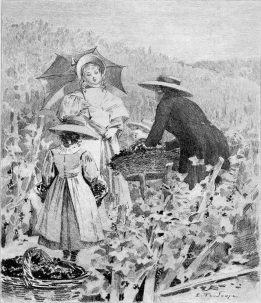
The Lily of the Valley
LA COMEDIE HUMAINE – Honoré de Balzac This novel can be found in the VIIth volume of the complete works of H. DE BALZAC by Veuve André HOUSSIAUX, éditeur, Hébert et Cie, Successeurs, 7, rue Perronet, 7 – Paris (1877), classified in this early edition under scènes de la vie de province. By naming this novel, which had previously appeared under the heading Scènes de la vie à la campagne (Scenes of country life), Balzac shows here one of the transfer models he used in his working methods.
Scenes from country life 
THE LILY OF THE VALLEY
Dedicated work, TO MR J.-B. NACQUART MEMBER OF THE ROYAL ACADEMY DE MEDECINE Dear Doctor, this is one of the most t the second foundation stone of a slowly and painstakingly edifice; I want to inscribe your name here, as much to thank the scholar who saved me in the past, as to celebrate the friend I have known all my life. De Balzac.
This novel, rather arbitrarily classified in the Scènes de la vie de campagne (Scenes of Country Life), didn’t immediately achieve the rank it was eventually given among Balzac’s great works.
Analysis of the work First published in the November and December 1835 issues of the Revue de Paris, then interrupted, Le Lys dans la vallée didn’t appear in booksellers’ shop windows until June 1836, after a lawsuit between Balzac and François Buloz, the magazine’s director. Le Lys dans la vallée thus belongs to a period of great production for Balzac, and at the same time to a particularly turbulent period in his love life. What’s more, Le Lys dans la vallée is a work of circumstance born of a wounded self-esteem. In 1834, Sainte-Beuve had just published his highly praised and celebrated novel Volupté. In this novel, he told the story of a great platonic passion, that of young Amaury for the beautiful and virtuous Madame de Couaën. This great love was described with great finesse and sensitivity, subtlety and infinite nuance, but the story ended badly, chastity being too hard a test for the unfortunate Amaury, who couldn’t help seeking sad consolation elsewhere. This novel awakened memories in Balzac. Whoever has not had his Madame de Couaën,” he wrote, “is not worthy of living. There is in this dangerous friendship of a married woman near whom the soul crawls, rises, sinks, indecisive, never resolving to audacity, desiring the fault, not committing it, all the delights of the first age…Yes, the first woman one meets with the illusions of youth is something holy and sacred.” Balzac was obviously touched by this evocation, which reminded him of his early days with Mme de Berny, the mistress of his twenty-two years. He found Sainte-Beuve’s novel “a little too puritanical,” and Mme de Couaën “not woman enough”. Unfortunately, shortly afterwards, Sainte-Beuve devoted a long article in the Revue des Deux Mondes to Balzac’s newly-published La Recherche de l’Absolu, with serious reservations. Balzac was very irritated by this aggression. Sainte-Beuve later recounted, according to a witness to the scene, that Balzac exclaimed, “He’ll pay me, I’ll run my pen across his body, I’ll do Volupté again.” The remake thus announced was The Lily of the Valley. Balzac was more skilful than Sainte-Beuve. He himself had experienced such a situation far more directly than Sainte-Beuve. Her heroine was virtuous, but troubled. He placed her in a happy valley where everything invited happiness, a wise happiness, but also life. He gave her all the excuses, an atrabilious, insufferable and perpetually grumpy husband, but also all the brakes, children in frail health, a deep sense of loyalty, an instinct for perfection in love. These were all contradictions. This admirable friendship began with all the shyness and fervor of youth. Félix de Vendenesse is nineteen years old. Later it becomes more serious, more profound, less dangerous because the lover’s extreme youth is no longer a carnal temptation, more dangerous because the young man of twenty-four, arrived, admired, become the king’s personal secretary, is the very image of the man to whom one can give oneself without remorse. Fortunately, the two lovers are separated: they couldn’t have lived on this tightrope for long. A twist of fate brings the novel to a close. Félix de Vandenesse, at the age of twenty-nine, becomes the prey of an English duchess, irritated by this spotless lover. Jealousy transforms the abandoned friend. But it’s too late. Grief and despair make this defeat impossible, and she ends up wishing for it. She died in tragic agony, crying out in vain for the happiness and caresses she had refused. Its Christian ending, however, reassures the reader. But can we believe it? There were many difficulties in this painting of perfect love, difficulties that are always those of Platonism: but there were also some admirable and striking pages, among Balzac’s most beautiful and unforgettable.

Madame de Mortsauf
The most striking is the first of all, the fiery kiss that the shy young man, strapped into the “nasty little blue ballroom suit”, surprisingly impresses on the naked shoulders of the indignant – as we’ll learn much later – and overwhelmed Mme de Mortsauf. Then, the admirable modesty and conventions of a love that is hidden and guessed at, constantly masked by affection and trust. At the same time, the valley is radiant and calm, yet fragrant and provocative, always present. At the end, Mme de Mortsauf’s tragic death: as moving as Father Goriot’s agony, a cry like hers to hold on to the life that is slipping away, a hopeless appeal to all that she still offered. These are some of Balzac’s finest pages. The novel’s charm is undeniable, but its characters, for various reasons, are less vigorous than in Balzac’s other novels. One of them, however, is an exception. It’s the husband’s, M. de Mortsauf. The Comte de Mortsauf (this strange name is explained in the Contes drolatiquesgiven to him in memory of a bourgeois from the time of Louis XI, who had been badly executed by the executioner and revived by the caressing care of an old maid) had spent fifteen years as an emigrant in the service of princes, under very difficult conditions. He had returned exhausted, ill and psychologically unstable. Balzac paints a striking picture of an atrabilaire, at once respectable because of his past and a background of loyalty and trustworthiness, yet at the same time quintet, short-tempered, authoritarian and childish, unbearable in everyday life. Balzac said: “I will have raised the statue of emigration. It’s better than that, it’s a character from Molière, a modern transcription of Le malade imaginaire, but with something touching and noble about the cause of his misfortune. In any case, the “salient character” of the novel, as Balzac himself observed.
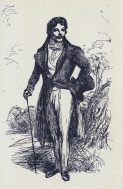
Félix de Vandenesse
Balzac admits that Félix de Vandenesse is a “sacrificial” character. The perfection of his love condemns him to immobility and contemplation. The end of the novel, with Mme de Mortsauf’s poignant regrets, seems to prove her wrong. What’s more, he belies his character by allowing himself to be drawn into a purely sensual adventure by the haughty Amazon he finds on his path. He is of interest to readers of Balzac because Balzac lent him his own childhood, his abandonment, his suffering, his mother’s cruelty and, later, the frustrations of his twentieth year. Some critics have found this portrait too cruel, seeing it as a transposition. It is, however, entirely in keeping with Balzac’s confession to Madame Hanska ten years later: “I never had a mother…I never told you about this wound, it was too horrible, and you have to see it to believe it. As soon as I was born, I was sent to be nursed by a gendarme; and I stayed there until I was four. From the age of four to six, I was sent to half-board, and at six and a half, I was sent to Vendôme, where I stayed until I was fourteen, in 1813, having seen my mother only twice. From the age of four to six, I saw her on Sundays…” This was the time of Mme de Balzac’s affair with M. de Margonne, from whom was born her son Henri, who was her favorite all his life. As for Mme de Mortsauf, the admirable, gentle figure of the novel is both the result of a sublime effort and a kind of deception. But, as in a detective story, we don’t know until the end. It had been burning since day one. That kiss, or rather that savage bite between her shoulders, had been a revelation to her. She had hidden this fire, this fire that had smoldered inside her, for ten years. At the end, when she dies, and everything for her has become impossible, she cries out, she calls out, she regrets with despair the life she was made for and didn’t get. So we understand that this union with the valley, this appeasement brought to him by the gentle Touraine countryside, was an illusion. She thought she was happy, because she told herself so. It’s not resignation, it’s a mirage. The power of what we want to be, the power of our idea of perfection, outweighs what we are. Balzac puts it very well, comparing Le Lys dans la vallée to Séraphita, and that’s what makes this novel so beautiful, as well as the secret disappointment it leaves behind. This work,” he wrote to Mme de Castries, “will be the last of the Etudes de mœurs, just as Séraphita is the last of the Etude philosophique. At the end of each work will stand a statue of an image of perfection, first on earth, then in heaven. Isn’t that a great idea?” It certainly was. But perfection casts an overly pure light on the works, which is not always understood. Hence the two readings that can be made, and have been made, of Le Lys dans la vallée. For some, the restraint of two lovers who know they love each other and refuse to succumb to it is the highest possible conception of love, the one that detaches it from carnal realities and gives it its nobility and duration: and they evoke Patrarch’s Laure, Dante’s Beatrice. For the others, Vandenesse is just a shy and indecisive man, excused at first by his extreme youth, but who then makes the woman he loves unhappy by wishing with her to be the saint she is not. Everyone is their own judge. There’s no doubt that Balzac, wanting to convey the idea of perfection in love, adopted the first reading. But he made a lot of corrections to his first draft, and some of the details are quite remarkable. For example, in the episode of the kiss given suddenly at the ball between the two white shoulders, Félix is “fifteen” in the first draft, later corrected to “seventeen” and finally to “nineteen”. What is Balzac thinking about, what memory? We don’t know. But in the end, it’s first and foremost, in his mind, a sensual adolescent craving that perhaps has the power to disturb – and does indeed disturb – by its very freshness. And at the end, in a much more brutal version of Mme de Mortsauf’s cries and regrets, in a page that Balzac deleted at Mme de Berny’s request, the dying Mme de Mortsauf cries out to Vandenesse these dreadful words: “To die without knowing love!… We only loved each other half-heartedly…Why didn’t you surprise me at night?” To capture all the iridescence of platonic love, its repressed desires, its surges, its appeasements, to accurately analyze these states of mind, Balzac had to make major corrections. The manuscript and proofs of Le Lys dans la vallée form a six-volume set. These considerable corrections caused delays in the delivery of the copy that the Revue de Paris was expecting. This inconvenience provoked numerous protests from Buloz. It was made worse by an unfortunate initiative. Balzac sent what La Revue de Paris had printed of the novel to La Revue étrangère, published in St Petersburg. It was reckless. But Buloz added treachery to this imprudence. For the chapters that followed, he sent La Revue étrangère the proofs composed in worn typeface known as “têtes de clous”, which Balzac used like our modern typewritten copies, and which were therefore only uncorrected copies of the first draft manuscript. Inevitably, this text contained errors, hasty redrafting and passages that had not been given their final form. Balzac was indignant that Madame Hanska could read a crude version of the Lys he had announced as a masterpiece. Buloz was no less so, because he had paid in advance for Le Lys, whose final text was never ready, and also for Séraphita and Mémoires de deux jeunes mariées, which Balzac never delivered.
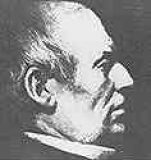
François Buloz, publisher
Buloz summoned Balzac in early January 1836. The sentence was not handed down until early June of that year. Balzac won on the essentials and Buloz was ordered to pay the costs. Chaix d’Est Ange’s plea for Buloz had included an ironic and cruel presentation of Le Lys. Balzac, who had just acquired the Chronique de Paris that was to ruin him, took his revenge by publishing a long and harsh account of the trial, which was merciless on Buloz. It was an ill-considered offensive, as Buloz was the owner of La Revue de Paris and La Revue des Deux Mondes at the time, and as such had considerable influence over the most respected critics. This dispute goes some way to explaining the hostile articles that appeared when the book was published. All the newspapers have been hostile to Le Lys,” Balzac announced to Madame Hanska, “all have hated it and spat on it. “That wasn’t quite true. Balzac had had a few defenders – Albéric Second, Le Courrier français, Girardin’s La Presse – but they were only committed to episodes. On the whole, the reviews were unfavorable. Amédée Pichot, in La Revue de Paris, had avenged his director with a burlesque presentation of the novel’s ending, which the magazine’s subscribers had not been able to read. Chaudes-Aigues rejected Balzac as a “moralist”, adding that “as a poet, he is yet to be born, (that) as a writer, he is not”, that this famous painter of women “must be placed among the writers of the boudoir and nothing more”. The royalist newspapers threw the last stone at him, accusing him of impiety and immorality. This disfavor, to which the Italian critic Rafaël de Cesare and more recently Moïse Le Yaouanc have given precise accounts, lasted a long time. Gustave Lanson wrote at the end of the 19th century: “Read, if you can, Le Lys dans la vallée… ” And a few years later, Emile Faguet declared: “This book is perhaps, except for a few details, the worst novel I know.” Shortly before 1914, Joachim Merlant, despite his favorable opinion of Balzac, wrote Voluptuousness above the Lilies in the valley and this judgment was repeated, without restriction, in a reprint of his Selected excerpts from Balzac in 1927. Rereading these reviews, we can see that it was Balzac’s style in this novel, often over-researched, too “literary” and sometimes amphigoric, that shocked the taste of contemporaries and the academic critics who followed them. These criticisms are not always untrue. In Le Lys, there’s a kind of poetic plethora, a verbal vagrancy, a writer’s “toast” in the expression of feelings that still bothers us today. Difficult feelings are more concise in reality. A single word often hurts more than a speech. Balzac didn’t always feel this way. There’s a power in brevity that is often the very hallmark of drama. In Bajazet, Roxane only said “Get out! It was a death sentence. The rehabilitation of the Lily began rather late, at the end of the last century. Taine, then André Bellessort, then Alain, then Claudel, then André Maurois, then many others, finally put Le Lys dans la vallée in the place it occupies today. “There is hardly a love story as profound or a figure as pathetic as Mme de Mortsauf,” wrote Claudel. It took a century for anyone to notice.
The Story Le Lys dans la vallée is the intense, platonic love story between Félix de Vandenesse, the youngest son of an aristocratic family, and the Comtesse Madame de Mortsauf, the virtuous wife of the dark, violent Comte de Mortsauf. In this largely autobiographical novel, Balzac transposed his affair with Laure de Berny, even going so far as to borrow details from La Dilecta ‘s private life: Mme de Mortsauf suffers from a heart condition, her children are ill. Félix de Vandenesse (like Balzac) recounts his unhappy childhood, when he felt unloved, even hated, and his encounter with a “celestial creature” who became for him a surrogate mother and an unattainable lover, much purer and more uncompromising than Madame de Berny. Pious at times to excess, her confessor was the excellent Abbé François Birotteau, who was criticized for his “lack of apostolic strength”. After several years of a chaste relationship, Félix met Lady Dudley in Paris, where her activities with the King opened the salons to her. It’s an English aristocrat who introduces him to the joys and passions of the flesh. Henriette learns of their relationship and begins to wither away, to the point of death. It’s possible that Countess Guidoboni-Visconti “posed” for the character of Lady Dudley (*) with a certain playfulness. Laure de Berny received the manuscript a few months before her death. She could read sentences addressed to her: “She was not the beloved, but the most loved (…). She became what the Florentine poet’s Beatrix was, the Venetian poet’s unblemished Laure, the mother of great thoughts, the unknown cause of life-saving resolutions, the support of the future (…) She gave me that Coligny-like constancy to conquer the conquerors, to rise from defeat, to weary the strongest conquerors (…). Although the novel was largely written at the Château de Saché, where Honoré de Balzac frequently stayed with his friend Jean de Margonne, the author of The Human Comedy borrowed the name of his friend Zulma Carraud’s property: Frapesle, to set the story of the Lilies.
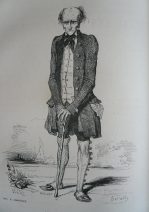
Comte de Mortsauf
(*) André Maurois – 1965 – p.234-236
The main characters The Count of Mortsauf Noble Touraine family represented by Comte de Mortsauf, born 1769, married in 1804 to Blanche-Henriette de Lenoncourt, born 1786, died 1823. It’s a man who returns from Emigration worn out and embittered, who doesn’t spread happiness around him.
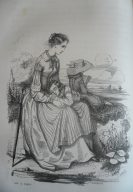
Blanche-Henriette de Mortsauf
Blanche-Henriette de Mortsauf Born Lenoncourt, only daughter of the Duke and Duchess de Lenoncourt, wife of the Count de Mortsauf. Mother of two children, Jacques and Madeleine, Henriette has the naiveté of a child – she shows the élans, the gaiety of a little girl. She’s as pure as a child. Unhappily married, she doesn’t see herself as such. Between the Count and her, there’s little intimacy and great respect. Jacques and Madeleine de Mortsauf Son and daughter of the Count and Countess de Mortsauf. Heirs to their father’s precarious health. Great birth, sad childhood, piety, mystical influence, gloomy marriage, worried motherhood. With the description of the children, we have all the features of Mme de Mortsauf. A child in fragile health, Jacques was a sickly child, nurtured by his mother. He died in 1826. Madeleine married the Comte de Chaulieu, becoming Duchess of Lenoncourt-Chaulieu. 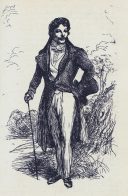 Félix-Amédée de Vandenesse Son of the Marquis de Vandenesse, a noble Touraine family, Félix de Vandenesse was born in 1794, first as a viscount, then as a count. At the age of nineteen, he fell in love with Blanche-Henriette de Mortsauf, a love that remained platonic. He leaves Mme de Mortsauf to fall in love with Lady Dudley, an English aristocrat.
Félix-Amédée de Vandenesse Son of the Marquis de Vandenesse, a noble Touraine family, Félix de Vandenesse was born in 1794, first as a viscount, then as a count. At the age of nineteen, he fell in love with Blanche-Henriette de Mortsauf, a love that remained platonic. He leaves Mme de Mortsauf to fall in love with Lady Dudley, an English aristocrat.
Source analysis: Preface, (tome XXII), compiled from the full text of the Comédie Humaine published by France Loisirs 1987 under the auspices of the Société des Amis d’Honoré de Balzac.
Source history and characters: Wikipedia.
No Comments